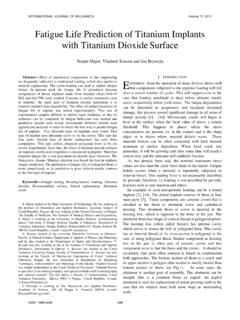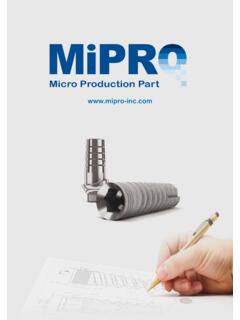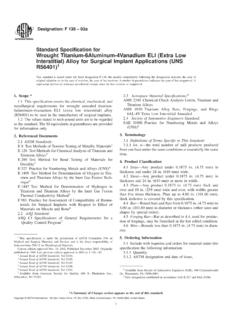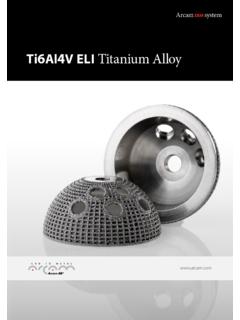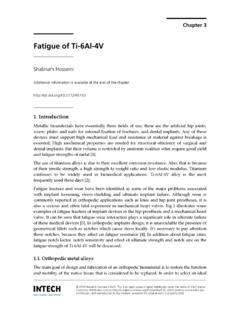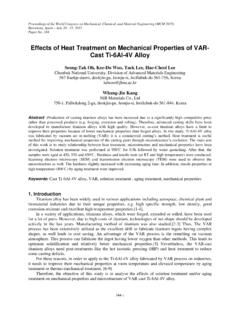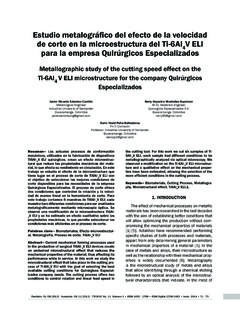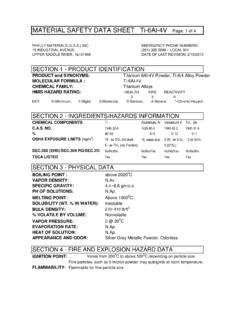Transcription of Mechanical Properties of Ti--6Al--4V Titanium Alloy with ...
1 Mechanical Properties of Ti 6Al 4V Titanium Alloy withSubmicrocrystalline Structure Produced by Severe Plastic DeformationSergey Zherebtsov1;2, Gennady Salishchev1, Rafail Galeyev1and Katsuhiro Maekawa31 Institute for Metals Superplasticity Problems, Russian Academy of Sciences, Ufa, 450001, Russia2 Satellite Venture Business Laboratory, Ibaraki University, Hitachi 316-8511, Japan3 The Research Center for Superplasticity, Ibaraki University, Hitachi 316-8511, JapanA comparative investigation of Mechanical Properties of Ti 6Al 4V Titanium Alloy with microcrystalline and submicrocrystallinestructures in the temperature range of 20 600 C has been carried out. The grain sizes under the submicrocrystalline and microcrystallineconditions are and 10mm, respectively.
2 The Alloy with the microcrystalline structure has been additionally subjected to a heat-strengthenedtreatment. The structure refinement of the Alloy results in increase in both strength and fatigue limit at room temperature by about 20%. Withincreasing deformation temperature, the strength of the submicrocrystalline Alloy is higher than that of the microcrystalline Alloy up to 400 , the creep strength of the submicrocrystalline Alloy is slightly lower than that of the heat-strengthened microcrystalline Alloy already at250 C.(Received May 16, 2005; Accepted July 21, 2005; Published September 15, 2005)Keywords:submicrocrystalline structure, Titanium Alloy , Mechanical Properties , strength, fatigue, creep1.
3 IntroductionSubmicrocrystalline (SMC) materials having a grain sizeof , that offer improved Mechanical proper-ties, have recently gained a great interest among researches inthe materials )Microstructure refinement of metalsand alloys into the SMC regime considerably increasesstrength and decreases the temperature at which superplas-ticity occurs by hundreds degrees, compared to their larger-grained 4)Industrial applications of the SMC materials have not beenfound yet, because the production of SMC billets with quitelarge dimensions involves difficult scientific and engineeringproblems. However, some severe plastic deformation (SPD)techniques have been developed recently for the productionof SMC structure in samples with a size of tens to hundreds ,5,6)The equal-channel angular extrusion(ECAE)1)is a technique for producing SMC structure inductile and soft enough metals and alloys ; for instance,aluminum, aluminum alloys and pure Titanium .
4 Massivesamples of hard-to-deform alloys , including Titanium alloysand steel, with SMC structure can be produced by means ofsubsequent work consisted of sequential deformation alongthree orthogonal directions, which is defined as the abc deformation 7)Another reason why SMC metals and alloys are not used asengineering materials arises from the issue described limited dimension of specimens is an impediment toextracting valid Mechanical Properties of SMC materialsproduced by some other processing methods. Owing to a verysmall size of samples, most Mechanical Properties of SMCmaterials have been primarily derived from uniaxial tension/compression tests and micro- or )This isthe reason why data for the Mechanical Properties of SMCmaterials are rather incomplete.
5 There are plenty of dataconcerning microhardness, strength and superplasticity ofSMC materials, which shows that very fine-grained materialspossess outstanding Properties . However, not enough infor-mation is presently available in literature on the fatigue,ductile, high-temperature strength and creep resistance ofSMC )The development of the method for producing massivesamples with SMC structures allows us to study theirmechanical Properties more systematically by using standardsamples along with standard procedures. The aim of thepresent paper is to evaluate the Mechanical Properties of theSMC Ti 6Al 4V Alloy both at room and high temperatures incomparison with those of the microcrystalline (MC, graindimension of some micrometers) heat-strengthened ExperimentalThe material used in this investigation is = titaniumalloy Ti 6Al 4V with the nominal chemical composition Al, V, Fe, O, Si in mass percent andbalance Titanium .
6 The Alloy has a transition temperature (atwhich ! ) of 995 C. The material was received inthe form of a hot rolled cylindrical rod with diameter of30 mm. Samples measuring 30 mm in diameter and 50 mm inlength were cut from the as-received bar for the with SMC structure have been prepared by meansof subsequent work consisted of sequential deformation of asample along three orthogonal directions, defined as the abc deformation method (Fig. 1).5,6)The grain sizeproduced by the method depends on temperature during )Therefore, the deformation temperatureshould be reduced as much as possible to have the smallestgrain size. On the other hand, ductility of the Alloy at lowtemperature is limited whereas a large deformation isrequired to produce samples with the SMC )Accordingly, the process should be started from a relativelyhigh temperature of about 700 C to avoid fracture of thesample.
7 As ductility of the sample is improved by the firstdeformation, the deformation temperature in the next stageMaterials Transactions, Vol. 46, No. 9 (2005) pp. 2020 to 2025#2005 The Japan Institute of Metalscan be decreased by 50 100 C. The final temperature of the abc deformation was 550 C. To attain a homogeneousfine-grained microstructure in a sample at least six or sevensequential compressions (conducting steps a through c in Fig. 1 two times, as a-b-c-a-b-c ) at each temperature )The deformation at each temperature was carried out underan isothermal condition at a strain rate of about10 3s the abc deformation, the Ti 6Al 4V samples withSMC structure were annealed at 650 C for an hour to reduceinternal stresses.
8 Optimum annealing conditions to attain themaximum structure improvement without grain growth weredetermined from pilot this study Mechanical Properties of the SMC Alloy arecompared with those of the MC Alloy . A homogeneous MCstructure of the Ti 6Al 4V Alloy was produced by means ofthe abc deformation process conducted at a highertemperature of about 930 )In this case the temperatureof deformation was not changed during the processing. Afterthat, the MC Alloy was subjected to a heat-strengtheningtreatment through water quenching from 945 C and thenaging at 500 C for 3 h. According to8)the Alloy has almostmaximum strength and fatigue limit after such samples for Mechanical tests were cut out from billetsof10 40 65mm3with SMC and MC structures.
9 Thetensile tests using cylindrical samples with of 3 mm diameterand 18 mm length were conducted at temperatures of 20 600 C at a speed of 1 mm/min. Tensile tests at roomtemperature were carried out on a Schenk machine usingan extensometer for a precise strain measurement. Tests athigh temperatures were conducted on an Instron machinein air. Mechanical Properties including yield stress (YS),ultimate tensile stress (UTS), area reduction (AR), totalelongation (TE), uniform elongation (UE) were determinedaccording to the Russian government standard GOST 1497-84. Specific work of deformation was calculated as an areaunder the corresponding true stress true area reductioncurve. Since plastic flow localizes very fast during the tensiletest (see section ), use curve, rather than ", seems tobe more suitable for determination specific work of defor-mation.
10 Because, in this case, the curves show realability of the alloys to plastic deformation. However specificwork of deformation has been estimated not for the wholesample, but for a small sample portion, which was reallydeformed during the tensile stress-controlled bending fatigue test was carried out toevaluate a fatigue limit (FL) of the SMC and MC with 8 mm gage width and 2 mm thick were testedfor2 107loading cycles. Ten specimens of each conditionwere utilized for the fatigue test. The fatigue test wasconducted at room temperature in air. The stress wasprescribed as a sinusoidal pulse at the frequency of 500 load ratio, which is defined as the ratio of the minimumload to the maximum load, was equal to creep test of the Alloy in SMC and MC conditions wascarried out using a creep machine of type 2147P 30/1000 attemperatures of 250 and 350 C in air.








